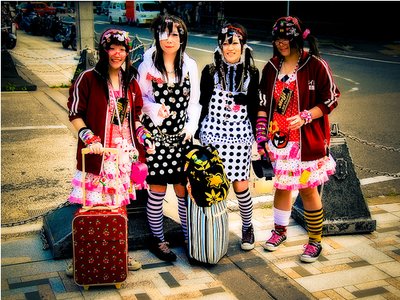

Is Modern Japanese Street Clothing More Western?
The Kimono with an Obi or the sash around the waist and the Geta were originated in Japan more than a thousand years ago. The material used to fabricate these varied form the most expensive of silks to the cheapest of linens. The kimono was also an heirloom often passed down from mother to daughter sometimes for several generations. Since the Kimono had one basic pattern, it could fit people with different body types by adjusting the neck and waistline. Modern Japanese clothing brings together the influences of the traditional Kimono with the modern western clothing.
The traditional Kimono however is relegated as a ceremonial dress in modern Japan. The kimono is now worn mostly only during the New Year or a wedding. Fashion shows in Japan bring together both these worlds by showcasing suits, which are draped like kimonos. Geta, which was the traditional footwear in Japan, shows its traces in modern day platform shoes. Fashion streets of Tokyo display brightly colored socks, which are a combination of the traditional tabi with western colors. Tabi is the traditional padded socks worn at home since the Japanese remain bare foot in their houses. Traces of the Sashiko, the traditional quilted coat can also be seen in modern coats. So, if you are in Tokyo, you may see a fine blend of the ancient Japanese and the western in the youth of modern Japan. Kimonos and platform shoes under them with a western hair style - this is what many young Japanese people can be seen attired in. however, modern Japanese clothing can be best described as largely western with elements from Japanese clothing incorporated.


The change Japanese street clothes probably came around after the Second World War. By 1946, a number of fashion magazines began gaining popularity in Japan, like Soen, New style that showed Japanese women how to dress. Not merely a magazine showcasing ready-made dresses and attires, these magazines served the purpose of fashion guides. The magazines showed Japanese women how to sew their Kimonos into dresses and their husband's old coats into suits. This was a complete sewing guide and soon silk Kimonos began transforming into silk dresses at par with New York and Paris designs and Japanese men began adorning suits.
Another reason for the ancient Kimono fading out to modern Japanese clothing is the ever-growing popularity of man-made fabrics. From 1975 to 1988, silk production fell by 39percent and since kimonos are made of silk, the kimono is losing popularity as an everyday wear. A number of stereotypes have also stopped the Kimono from making a comeback. Younger women lack assistance in buying a Kimono; what colors should they buy and even where to buy them is an unanswered question for a large percentage. It is also a common thought that they are hard to wear alone and that a Kimono is only meant for special occasions. The thought that they are expensive also discourages many young potential buyers.
A total westernization will never happen owing to Japan's rich culture but a healthy mix of western and traditional can be seen everyday on the streets of Tokyo and many other cities and towns. A Nike t-shirt over a skirt and a Geta is not an uncommon sight; the only saddening part may perhaps be the downhill journey of the traditional Kimono in the modern Japanese clothing.(http://EzineArticles.com/?expert=Christopher_Schwebius)
Find out the other guide on Fashion Boutique.